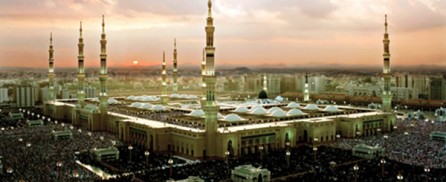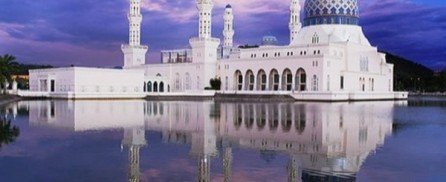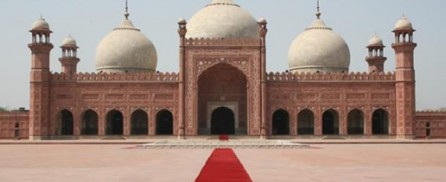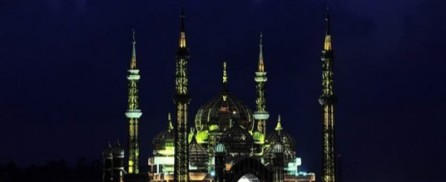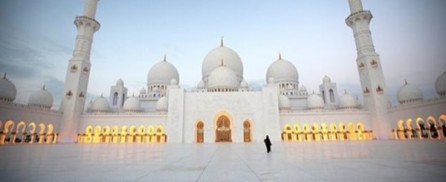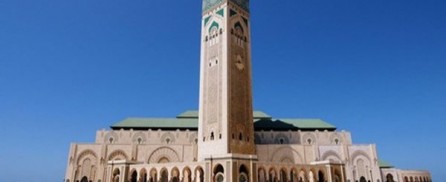Grand Mosques
-
Al-Masjid Al-Haram
Saudi Arabia
Al-Masjid Al-Haram (Arabic: المسجد الحرام, The Sacred Mosque or The Grand Mosque) is in the city of Mecca, Saudi Arabia. It is the largest and oldest mosque in the world and surrounds one of Islam's holiest places, the Kaaba.[ Muslims face in the direction of the Kaaba while performing Salat. One of the Five Pillars of Islam requires every Muslim to perform the Hajj pilgrimage at least once in his or her lifetime if able to do so, including circumambulation of the Kaaba.
The current structure covers an area of 356,800 square metres (88.2 acres) including the outdoor and indoor praying spaces and can accommodate up to two million worshipers during the Hajj period, one of the largest annual gatherings of people in the world. Unlike many other mosques which are segregated, men and women can worship at Al-Masjid Al-Haram together. -
Masjid Al-Nabawi Medina
Saudi Arabia
Al-Masjid al-Nabawī (Arabic: المسجد النبوي), The Prophet's Mosque, built by the Islamic prophet Muhammad situated in the city of Medina. It is the second holiest site in Islam (the first being the Masjid al-Haram in Mecca). It was the second mosque built in history and is now one of the largest mosques in the world. After an expansion during the reign of al-Walid I, it also now incorporates the site of the final resting place of Muhammad and early Muslim leaders Abu Bakr and Umar.
The site was originally adjacent to Muhammad's house; he settled there after his Hijra (emigration) to Medina in 622. He shared in the heavy work of construction. The original mosque was an open-air building.
In 1909, it became the first place in the Arabian Peninsula to be provided with electrical lights. The mosque is under the control of the Custodian of the Two Holy Mosques. One of the most notable features of the site is the Green Dome in the south-east corner of the mosque, originally Aisha's house, where the tomb of Muhammad is located. In 1279, a wooden cupola was built over the tomb which was later rebuilt and renovated multiple times in late 15th century and once in 1817. The dome was first painted green in 1837, and later became known as the Green Dome. -
Masjid Al-Aqsa
Jerusalem
First Qibla - Bait-al-Maqdis (Al-Aqsa):
AT THE HEART OF JERUSALEM is the Masjid Al Aqsa or Al-Haram Ash-Shareef (The Noble Sanctuary). The third most sacred mosque in the world (after Masjid al-Haram in Makkah and Masjid Nabawi in Medinah), enclosing over 35 acres of fountains, gardens, buildings and domes. At its southernmost end is Masjid Al Aqsa, which was re-built by Khalifa Omar Bin Al-Kattab in the year 19 Hijri. At its center is the celebrated Dome of the Rock. The entire area is regarded as Baitul-Maqdis or Al-Qudus.- Most scholars are of the opinion that Masjid Al Aqsa was first built by Prophet Adam.
- Ibrahim (as) rebuilt the Masjid Al Aqsa in Jerusalem as he and Ismail rebuilt the Ka'ba in Makkah.
- Prophet Daud (as) began the rebuilding of Masjid Al Aqsa.
- It was Prophet Sulayman (as) who finally completed the building of Masjid Al Aqsa.
- Masjid Al Aqsa built by Sulayman (as) was destroyed in 587 BC by Nebuchadnezzar King of Babylon.
- The Jews call this same Masjid Al Aqsa built by Sulayman as their Temple.
- The Jews re-built their Temple on the same site in 167 BC but was destroyed in 70 AD and Jews banished from Jerusalem.
- The site of Masjid Al Aqsa remained barren and was used as a rubbish tip for nearly 600 years until the Great Khalifah Umar bin Khattab liberated Jerusalem in 637/8 AD.
- The Khalifah Umar bin Khattab began the foundation of Masjid Al Aqsa and a timber mosque was built.
- The Umayyad Khalifah, Abd' al Malik ibn Marwan in 691/2 [72/73 AH] began the construction of, Dome of the Rock - today this is the Golden Domed Mosque.
- The al Buraq wall or Western Wall where Prophet Muhammad tied his animal the Buraq on the night journey of al Isra is what the Jews call the wailing wall.
- To Muslims it is the land or the Haram Sharif area which is most holy and important.
- The Haram area of Al Aqsa has within it the Masjid Al Aqsa [Black Domed Mosque] and Dome of the Rock [the Golden Domed Mosque].
- Israel occupied Masjid Al Aqsa in 1967.
- The fundamentalist Jews have made 100's of attempts to destroy Al Aqsa since 1967 when they occupied it. A fire in 1967 started by their help destroyed the 900 year old Mimbar installed by Slaudeen Ayub, the Great Muslim Hero.
- The fundamentalist want to blow up and destroy Masjidul Al Aqsa and replace it with a Jewish Temple
-
Kota Kinabalu City Floating Mosque
Malaysia
From a distance, the Kota Kinabalu City Mosque seems to float on top of the water. Although the optical illusion is created by a man-made lagoon nestled around the mosque, the building's reflection in the cool blue water gives the fantastic mosque an air of mystery and beauty. Built in 2000, after Kota Kinabalu became a city, the mosque can hold 12,000 worshippers at once. When the mosque is illuminated over the black water of Likas Bay, it is considered one of the most beautiful structures in the city and in the entire country of Malaysia. The mosque was designed to resemble the Prophet's Mosque in Medina, which is the final resting place of Mohammad.
-
Sultan Omar Ali Saifuddin Mosque
Brunei
Sultan Omar Ali Saifuddin Mosque is an exclamation point above the Brunei River. Built on an artificial lagoon on the banks of the river, the mosque was designed solely for prayer to Allah.
The golden topped dome of the mosque shines in the night sky. With the population of only 400,000, two-third of the population of Brunei adhere to Islam, laws are based on Sharia.
The beauty and architectural design attract and draw in tourists; the mosque's true purpose becomes clear when visitors realize they cannot enter the mosque, except in prayer. The mosque is regarded as one of the most beautiful structures in the country and declared by most to be the most beautiful and fantastic mosque in Southeast Asia. -
Badshahi Mosque
Pakistan
For 313 years, the Badshahi Mosque was the largest in the world, with capacity for 100,000 worshippers. Built in 1673, the mosque was visible from almost 10 miles away. The crown jewel of Lahore, the Badshahi Mosque was a symbol of power in the Mughal Empire.
The mosque was overtaken by Sikhs during the civil war and exploited for military purposes and as a stable for horses. During the civil war, guns were mounted on the 170 foot high minarets to bombard a group of refugee in the nearby Lahore Fort.
Throughout British rule, the mosque continued to be used for military storage. After 1947, when Pakistan became an independent Muslim state, the mosque was returned to its original purpose, and extensive repairs were undertaken. The Badshahi Mosque has been restored to its original 17th century condition. -
Crystal Mosque
Malaysia
Malaysia's Islamic Heritage Park on Wan Man Island blurs the line between prayer and commerce. Although it is a tourist attraction that cost $80 million, it also features one of the most spectacular Islamic places of worship in the world, the Crystal Mosque.
Created out of steel and glass, the mosque is unlike any other in the world. Its sleek and modern look reflects off the water and the mosque is often illuminated from the inside, which makes its glass domes shine. .
The Islam Heritage Park also features replicas of many of the world's most famous mosques from around the world. Many in Malaysia were irritated that the Crystal Mosque embraced elements of Chinese architecture and design. -
Sheikh Zayed Grand Mosque
United Arab Emirates
Sheikh Zayed bin Sultan Al Nahyan is often called the father of the United Arab Emirates. As the first president of the country, he worked to push the UAE into the modern world, and was caught in crossfire between modernity and tradition throughout his reign. As a lasting monument to his struggle, he began building the Grand Mosque in 1996.
Sheikh Zayed died in 2004 and was buried on the grounds of the mosque. Three years later, the impressive building that had cost $545 million to create, finally opened its doors to the public. With a capacity for 40,000 worshippers, it is one of the largest mosques in the world. -
Sheikh Lotfallah Mosque
Iran
Sheikh Lotfallah Mosque was completed in 1619 after nearly 20 years of work. Originally, it was a private and luxurious place of worship for Shah Abbas I and the women of his court. The mosque has an underground passage way for women to enter the mosque without being seen by passerby on the square, thus giving the building its nickname, the Women's Mosque.
Lavished with elaborate calligraphy of Quranic verses and multi-colored mosaics, every tile was laid with precision and the main dome is dominated by a peacock that changes color and shape as light reflects off of the mosque's interior.
During the 17th century after it was built, the mosque was not open to the public, and served only as a private sanctuary. Today, it is open to everyone and was declared a UNESCO World Heritage Site. -
Qolşärif Mosque
Russia
Replica of mosque destroyed by Russia in the 16th century
Qolşärif Mosque was constructed in the 16th century in the Muslim-dominated Khanate of Kazan. Qolşärif was a massive place of worship in the town and was famed to be the largest mosque in Europe. The Mosque was a symbol of Tatar strength in the era.
Unfortunately, in 1552, Ivan the Terrible was gaining power throughout Russia, and eventually came to Kazan, stormed the city and destroyed the monumental mosque.
In 1996, a project began in Kazan to rebuild the Qolşärif Mosque funded partly by Saudi Arabia and the United Arab Emirates, the final project was finished in 2005. With soaring teal-topped minarets and whitewashed arches, the new mosque connects the old Kazan Khanate with modern Russian and Islamic architecture, and serves to keep the memory of the 16th century mosque alive. -
Hassan Ii Mosque
Morocco
It took over seven years and 10,000 craftsmen to construct the Hassan II Mosque, but the result is a modern and massive tribute to the former King of Morocco that beautifully blends traditional Moorish architecture with 20th century innovation and equipment.
Although it is only the 7th largest mosque in the world, Hassan II claims the title of having the largest minaret. Capped with a spotlight that shines east towards Mecca, the minaret is 700-feet tall, towering above the Atlantic Ocean. Almost lighthouse-like in its position, it is also built directly on the Atlantic Ocean on reclaimed land.


